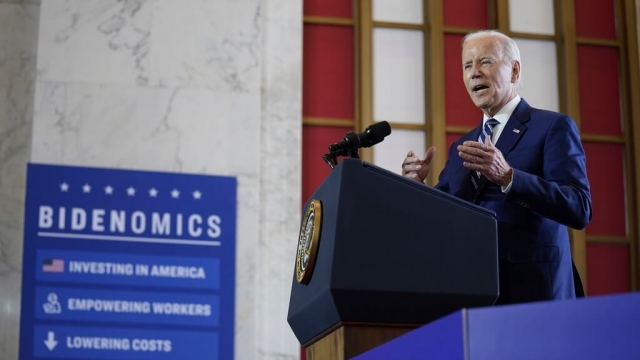President Joe Biden leaned into rebranding on his administration's handling of economic recovery: Bidenomics.
President Biden kicked off the second round of the administration's "Investing in America" tour on Wednesday in Chicago, saying his administration's policies had helped America's middle class get back on its economic feet.
"Bidenomics is about the future," President Biden said in his speech, alongside posters printed with the phrase. "Bidenomics is just another way of saying: Restore the American dream."
President Biden says his economic policy focuses on growing the middle class by investing in America, educating workers and promoting competition. President Biden doubled down on a break from "trickle-down economics" and a shift toward a plan to "build an economy from the middle out, the bottom up," contrasting his policies with that of Republicans and the last administration.
"You know, reversing 40 years of Republican trickle-down economics that helped few but hurt the middle class, it’s going to take some time," President Biden said. "But we’re in a place where some big pieces — and we’re moving in the direction where we can get some more done and people will see it."
Over the last year, the Biden White House has rolled out billions of dollars in new funding and initiatives for renewable energy, green transportation, and infrastructure overhauls to repair bridges and build out broadband access.
"It takes time for them to see it. And I’m not here to declare victory on the economy. I’m here to say we have a plan that's turning things around incredibly quickly," President Biden said.
In that same period, inflation has cooled, unemployment is close to record lows and consumer confidence is up, according to the Conference Board, which tracks and forecasts U.S. business conditions.
But polling shows the public is lukewarm on President Biden's economic approach: A poll by the Associated Press and the NORC Center for Public Affairs Research found just 34% of Americans approve of the president's handling of the economy.
SEE MORE: Biden to announce over $600 million for 'climate adaption projects'
The White House argues Americans largely approve of his specific policies.
"I think one of the problems is that some of the questions that get asked, they just invoke the partisanship and the kind of tribalism that's so, unfortunately, endemic to our politics today," said Jared Bernstein, chair of the White House Council of Economic Advisors. "But if you get around that by saying, 'What do you think of the things that Biden is actually doing on the ground?' As I said, you got poll numbers that are north of 70%."
But economic messaging can be difficult, according to Todd Belt, director of political management at George Washington University.
"It's really hard to tell people that things are going well, if they're going to the grocery store and seeing their bills go up and up," Belt said. "And inflation has tapered off a little bit, but it's still there. And so the President needs to get out there and talk about things that are popular with people such as the building of roads and bridges, and other aspects of his inflation Reduction Act."
The administration acknowledges inflation is "too high" but argues President Biden's agenda promotes lowering prices, highlights falling inflation rates and has tried to quell fears over a recession.
"If you look at where the economy is, right now, the indicators that represent recession, whether it's consumer spending, whether it's unemployment, which by the way, has been below 4%, for a year and a half. Those are seriously non-recessionary numbers. So any argument that says we're in a recession right now, it's sort of like looking out the window, and you know, it's sunny, but you're telling me it's snowing, so we can look at the facts where they are today, they are non-recessionary," said Bernstein.
SEE MORE: US inflation rate below 5% for first time in 2 years
Trending stories at Scrippsnews.com




